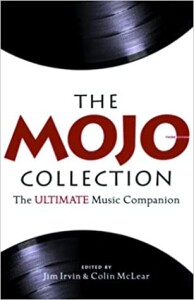 Trying to fill out your CD collection of reissued gems from the 1960s and 1970s? Wondering which Frank Sinatra or Elvis Presley albums are classics? Spent the ’90s listening to heavy metal and wonder what else you missed? Trying to find something from the ’80s worth listening to? The Mojo Collection (Third Edition) might be a good place to start.
Trying to fill out your CD collection of reissued gems from the 1960s and 1970s? Wondering which Frank Sinatra or Elvis Presley albums are classics? Spent the ’90s listening to heavy metal and wonder what else you missed? Trying to find something from the ’80s worth listening to? The Mojo Collection (Third Edition) might be a good place to start.
It’s unclear whether these reviews originally appeared in any form in Mojo Magazine, the British pop journal. It covers hundreds of albums, in articles written by dozens of writers. As it says in the introduction, “This is a celebration of an art form — the pop album. We’ve selected hundreds of them from the very first vinyl pop albums in 1946 to important releases from the first half of 2003…”
The albums aren’t ranked or rated. They’re presented in chronological order, from The Voice of Frank Sinatra in 1946 to Nick Cave and the Bad Seeds’ Nocturama in 2003. More than 700 of them. A BIG book, one for the music-lover to while away many comforting hours with.
Since it’s written by British music journalists, it has a much more Brit-centric view of the significant albums than would a similar publication by Rolling Stone, All Music Guide or Music Hound. That alone adds some value for the American reader looking for a slightly different perspective, and for the English or European reader sated with the American dominance of all things entertaining.
In addition to the reviews themselves, the book gives a column of information on each album: record label, producers, place and date of recording, release date, US and UK chart peaks, personnel, track listing, running time and the file number of the current CD if it’s in print. There are also suggestions for further listening and further reading, and a reference to other reviews in the book if you “like this.” All in all, it’s a pretty thorough approach, although the sheer volume of facts presented gives more opportunities for errors (of omission and commission) to creep in. I daresay any collector can find several examples of personnel left off or misidentified, but those sorts of things happen with all but the most meticulous editing. A little more frustrating is a tendency to omit chart peaks entirely; generally, when an album failed to chart, the entry says “none,” but when the chart entry isn’t even there, as seems to happen more frequently toward the end, the reader is left guessing, never a good thing.
However, those UK and US chart peak figures are among the most interesting factoids, pointing up as they do the sometimes vast difference in taste and sales between the two countries. It’s understandable, for instance, that Jethro Tull’s Stand Up hit No. 1 in the UK and only No. 20 in the US; but the fact that Elvis Presley’s From Elvin in Memphis was a No. 1 hit in the UK but only No. 13 in the US is puzzling. Again and again, quality American acts seem more appreciated in England than the US, among them: Iggy Pop’s Lust For Life (1977), Robert Cray’s Strong Persuader (1986), and Aimee Mann’s Whatever (1993). Then again, one is content to let England have the techno group Orbital’s second eponymous release, which contained a track titled “Halcyon,” described here as ‘a melancholy, mid-tempo track based around a sample from Opus 3’s ravetastic cover of Edward Barton’s “It’s A Fine Day.”‘ Ravetastic? Whatever.
There are a lot of run-on sentences in these reviews; or rather what would be considered run-on sentences in American English. I see similar examples in UK science fiction, so perhaps it’s considered OK in some less-formal settings in England.
In the back of the book is a good section on compilations of various sorts: soundtracks, various-artists comps, tributes and best-ofs. Also an essay on reggae and one on, of all things, lounge music.
Perhaps “The Ultimate Music Companion” is hyperbole, but The Mojo Collection is a solid entry in the world of album guides.
(Canongate UK, Grove Atlantic US, 2003)
